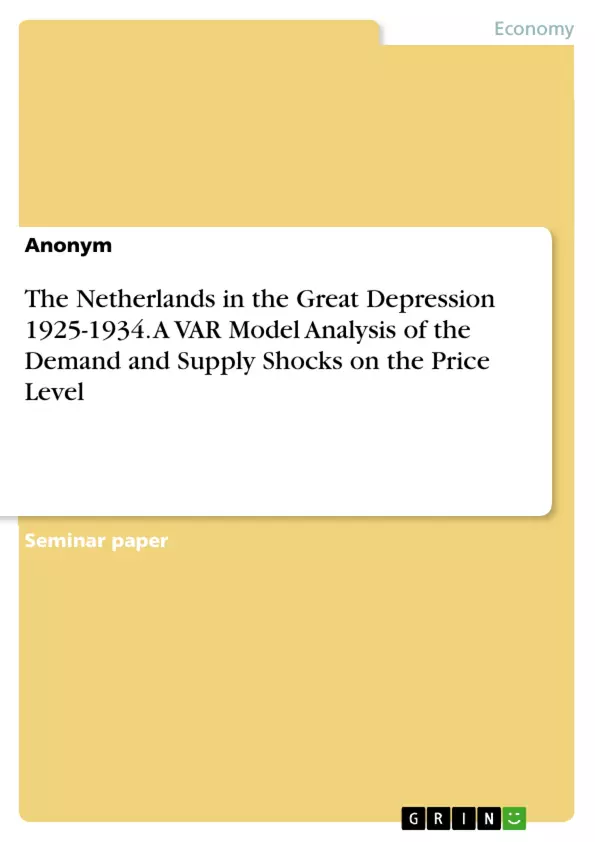In this paper, we apply an empirical analysis to provide an answer to the Bullionist Controversy in Great Britain in the 18th century adopted to the Netherlands in the Great Depression. Therefore, we answer the question whether the price evolution in this period has been mostly driven by demand or supply shocks and whether remaining in the gold standard was a good decision for the economic development or not.
For our analysis we estimated a vector autoregressive model (VAR) and applied the Blanchard-Quah decomposition to identify the demand and supply shocks on the output growth and inflation. Therefore, we use an impulse response and a Forecast Error Variance Decomposition to illustrate our results.
We argue in this paper that the impact of the Great Depression on the economy of the Netherlands has been bigger because it stayed part of the Gold Bloc and therefore maintain convertibility. Thus, we bring forward the argument of the bullionist that the price shock has been a result of a demand shock. he gold standard as a consequence has led to an overvaluation of the Dutch currency (guilder). For a small open economy like the Netherlands which is highly dependent of exports and has a big shipping sector the exchange rate plays a crucial role. Thus, the overvaluation resulted in a negative demand shock.
Furthermore the persistent deflation and downward pressure on wages have led to even higher deflation expectations of the population, what dampened the aggregate supply. Finally, the policy decisions of the government were incapable to reduce the problem and get out of the depression. Only after the suspension of the convertibility to the gold standard and a devaluation of the currency the economy was able to recover. For this reason an earlier suspension would have had reduced the length and the intensity of the Great Depression for the economy of the Netherlands.
Inhaltsverzeichnis (Table of Contents)
- Introduction
- Historical Background
- Method
- Empirical Analysis
- Conclusion
Zielsetzung und Themenschwerpunkte (Objectives and Key Themes)
This paper analyzes the impact of the Great Depression on the Netherlands, focusing on the Bullionist Controversy. The goal is to determine whether the price evolution during this period was driven primarily by demand or supply shocks and whether remaining in the gold standard was beneficial for the Dutch economy.
- The role of the gold standard in the Netherlands during the Great Depression.
- The impact of demand and supply shocks on price evolution and economic development.
- The effects of deflation and downward pressure on wages.
- The effectiveness of government policies in mitigating the Great Depression.
- The influence of the Bullionist Controversy on the Dutch economy.
Zusammenfassung der Kapitel (Chapter Summaries)
- Introduction: This chapter introduces the topic of the Bullionist Controversy in the Netherlands during the Great Depression. It discusses the context of the Great Depression in the Netherlands and outlines the research question, which focuses on the relative influence of demand and supply shocks on price evolution and the economic impact of the gold standard.
- Historical Background: This chapter provides a historical overview of the political and economic situation in the Netherlands, specifically focusing on its relationship with the gold standard and the impact of the Great Depression. It details the Netherlands' economic performance in the 1910s and 1920s, highlighting the role of international trade and the consequences of war-related economic disruptions. The chapter also examines the economic policies implemented by the Dutch government during the Great Depression, including measures aimed at stabilizing prices and wages, and the effects of these policies on the economy.
- Method: This chapter outlines the methodology employed in the study. It explains the use of a vector autoregressive (VAR) model to analyze the relationship between output growth and price index growth. The chapter discusses the Blanchard-Quah decomposition technique, which is used to identify demand and supply shocks and their impacts on the economy.
Schlüsselwörter (Keywords)
The paper focuses on the Bullionist Controversy, the Great Depression, the Netherlands, the gold standard, demand shocks, supply shocks, price evolution, deflation, government policies, and the impact of economic shocks on a small open economy.
- Quote paper
- Anonym (Author), 2016, The Netherlands in the Great Depression 1925-1934. A VAR Model Analysis of the Demand and Supply Shocks on the Price Level, Munich, GRIN Verlag, https://www.grin.com/document/353297



